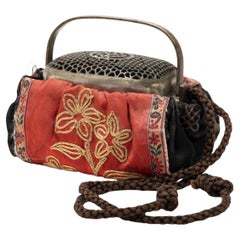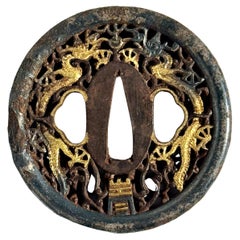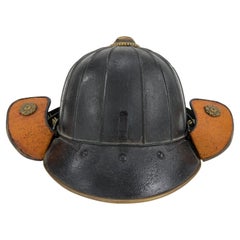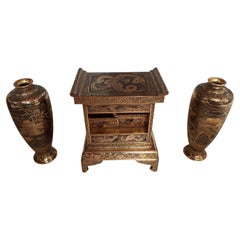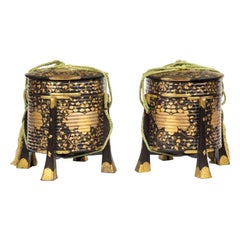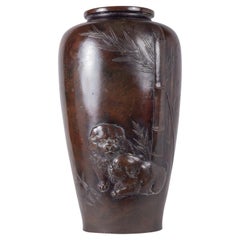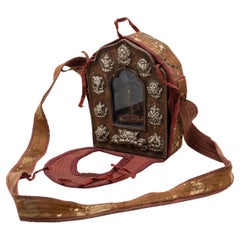Fabric Metalwork
13
to
2
9
3
13
13
13
1
9
3
3
1
283,691
1,848
662
351
304
13
13
7
3
3
Material: Fabric
Chinese Petite Brass Brazier with Embroidered Pouch, c. 1850
Located in Chicago, IL
Filled with burning coals, this petite 19th-century brass brazier once warmed the hands of a well-to-do person on a cold winter's night in northern China. The brazier is crafted of w...
Category
Mid-19th Century Chinese Qing Antique Fabric Metalwork
Materials
Brass
Japanese Nanban Tsuba with Dragons, Edo Period, early 19th century, Japan
Located in Austin, TX
A dramatic Japanese iron tsuba in the nanban (foreign) style, decorated with dragons and openwork and inlaid with silver and gold, Edo Period, early 19th century, Japan.
The fantast...
Category
Early 19th Century Japanese Edo Antique Fabric Metalwork
Materials
Gold, Iron, Silver
Japanese Cigarette Case In The Style Of Komai, Meiji Era Japan
By Komai
Located in Saverne, Grand Est
High quality gold damascened iron case, representing a dragon in the middle of the waves, Mount Fuji in the background on one side, birds in a floral environment on the other.
Delive...
Category
Late 19th Century Japanese Meiji Antique Fabric Metalwork
Materials
Iron
Japanese Samurai Helmet Kabuto Edo Period (1603-1867)
Located in Hampstead, QC
A Japanese Samurai black-lacquered helmet (kabuto) in suji bachi style and of a goshozan shape consisting of the:
- main dome (hachi) made from 16 plates in natural iron riveted to...
Category
Early 19th Century Japanese Edo Antique Fabric Metalwork
Materials
Iron
Tibetan Gilt Copper Alloy Mask on Display Stand
Located in Atlanta, GA
An impressive copper alloy mask of Arhat, the disciple and follower of Buddha (also known as Luohan in Chinese) from Tibetan region circa 19th century. The larger-than-life mask has striking iconic facial features: large, rounded eyes under bushy eyebrows, wide nostrils, full lips and elongated earlobes. The molded mask is lined with a red lacquered line-like textile on the back with seams still visible on the edge. Masks with realistic rendition of Arhats were not as common as the fantastical and fierce deity masks...
Category
19th Century Tibetan Tibetan Antique Fabric Metalwork
Materials
Copper
Cabinet and Two Vases in Gold Damascened Iron
By Komai
Located in Saverne, Grand Est
Exceptional set composed of a cabinet and two miniature vases in gold damascened iron. The cabinet opens in front with four drawers. The three pieces are marked with Mount Fuji, signature of the artist Fujii Yoshitoyo...
Category
Early 20th Century Japanese Fabric Metalwork
Materials
Iron
Tibetan Repoussé Traveling Shrine, c. 1850
Located in Chicago, IL
Tibetan traveling shrines, known as Gau, were believed to offer protective powers and were used to hold and carry sacred objects during long journeys....
Category
Mid-19th Century Tibetan Tibetan Antique Fabric Metalwork
Materials
Brass
Go-Mai Uchidashi Dō Tosei Gusoku Samurai Armor Decorated with an Embossed Rabbit
Located in Milano, IT
Go-mai uchidashi do tosei gusoku
Samurai armor decorated with an embossed rabbit
Edo period, 19th century
This samurai armor is complete and original, with consistent elements...
Category
19th Century Japanese Antique Fabric Metalwork
Materials
Iron
Edo Period Chain Mail Armor Jacket, Kusari or Karuta, Japan
Located in Point Richmond, CA
Edo period Chain Mail Armor Jacket, Kusari or sometimes known as Karuta, Japan
Japanese chain mail armor jacket is composed of brass metal plates linked together with metal wires an...
Category
Late 18th Century Japanese Edo Antique Fabric Metalwork
Materials
Brass
Suit of Red Lacquer Japanese Fighting Armor of the Late Edo Period
Located in San Francisco, CA
Suit of red lacquer Japanese fighting armour of the late Edo period, (1716-1868). Desirable coral red lacquer is original and unrestored.
Composed of a helmet, (Kabuto) breast plate (Do) and shoulder, arm protection (chainmail). Displayed with a later recreation expressive face plate of modern manufacture (nose, mustache). Also displayed with (photos 3 & 4) a period red lacquer partial face plate (Hambo) with replacement throat guards. All of the assembled parts are of same age, quality and color.
Old silk and linen sleeve and helmet linings decayed or shredding.
The Meiji period wood...
Category
19th Century Japanese Antique Fabric Metalwork
Materials
Iron
Pair 19th Century Chinese Lead Vases Inlayed with Bronze Lamps
Located in Hudson, NY
This pair of vases are from China. Made as part of a 19th century alter garniture set the pair are now lamps. Cast in lead which has been inlayed with bronze decorative elements incl...
Category
1880s Chinese Archaistic Antique Fabric Metalwork
Materials
Bronze, Lead
Tibetan Gau Traveling Shrine with Silk Case, c. 1900
Located in Chicago, IL
Tibetan traveling shrines, known as Gau, were believed to offer protective powers and were used to hold and carry sacred objects during long journeys. Crafted over a century ago, Bud...
Category
Early 20th Century Tibetan Tibetan Fabric Metalwork
Materials
Brass, Copper
Chinese Late Qing Dynasty Large Brass Gong with Carved Giltwood Support, c. 1900
Located in San Francisco, CA
An impressively sized and visually (and aurally) dramatic circa 1900 Chinese late Qing dynasty brass gong with hand-carved giltwood support piece and newer ...
Category
Early 1900s Chinese Qing Antique Fabric Metalwork
Materials
Brass
Related Items
Pair of Edo Period Black and Gold Lacquer Samurai Helmet Boxes
Located in Lymington, Hampshire
A pair of Edo period black and gold lacquer Samurai helmet boxes (Hakko Bako), each of ribbed cylindrical form with a lid, a black lacquer interior,...
Category
19th Century Japanese Edo Antique Fabric Metalwork
Materials
Lacquer
19th Century Japanese Bronze Vase
Located in Brighton, Sussex
A very good quality Meiji period (1868-1912) Japanese patinated bronze vase, depicting two seated dogs below a Bamboo plant.
Category
Late 19th Century Japanese Japonisme Antique Fabric Metalwork
Materials
Bronze
Densatil Gilt Bronze Caryatid Figure, Tibet, 15th Century
Located in Austin, TX
A heavy and solidly cast, richly gilt, bronze caryatid figure from Densatil Monastery, Central Tibet, early 15th century or earlier.
Cast in the form of two four armed figures standing back to back in tribhanga (thrice bent position) on a lotus platform, this piece would originally have served as a pillar for a larger seated deity...
Category
15th Century and Earlier Tibetan Tibetan Antique Fabric Metalwork
Materials
Bronze
Sujibachi kabuto 62-plate samurai helmet Haruta school, Edo period
Located in Milano, IT
Sujibachi kabuto
62-plate samurai helmet
Haruta school, Edo period
17th-18th century
A lamellar helmet consisting of sixty-two plates joined with five rows of rivets. The surface is...
Category
Mid-17th Century Japanese Antique Fabric Metalwork
Materials
Iron
Free Shipping
H 19.69 in W 19.69 in D 19.69 in
Japanese Cast Bronze "Longevity" Mirror, Edo Period, 18th Century, Japan
Located in Austin, TX
A heavy and finely cast Japanese bronze mirror with longevity symbols, Edo Period, 18th century, Japan.
The small, round mirror with high walls...
Category
Late 18th Century Japanese Edo Antique Fabric Metalwork
Materials
Bronze
Large Bronze Tibetan Vase with Handles
Located in Alessandria, Piemonte
Large Tibet bronze and copper vase with handles: exceptional and perfect.
Sizes: diameter at the top cm. 52, with handles cm. 61. Base 35 cm.
High cm. 43....
Category
Late 19th Century Tibetan Other Antique Fabric Metalwork
Materials
Bronze
Two Small Japanese Cloisonne Dragon Vases, Early 20th Century, Japan
Located in Austin, TX
Two charming, small Japanese cloisonné dragon vases, Meiji to Taisho period, early 20th century, Japan.
The miniature vases of baluster f...
Category
Early 20th Century Japanese Taisho Fabric Metalwork
Materials
Copper, Enamel, Foil
Okitenugui Kabuto Samurai Helmet Shaped as a Head Towel Saika, Early Edo Period
Located in Milano, IT
Okitenugui kabuto
Samurai helmet shaped as a head towel
Saika, early Edo period, 17th century
The Haruta armorers who moved to Kii province in the early 17th century, took the name from the village where they worked, Saika, near Wakayama, possibly on request of the local daimyo, Asano Yukinaga, a great armour amateur. Specialised in the construction of plate helmets, they produced mainly two typologies of kabuto: one with six plates covered with a chrysanthemum-shaped plate on top and one shaped as a “head towel”, called okitenugui. The latter type of kabuto employs very heavy plates crafted in a curved manner and was improved in order to make it resistant to firearms.
This okitenugui kabuto features some distinctive decorations of the Haruta school, including the application of cut-out iron elements, including eyebrows, washers and lozenge-shaped decorations on the sides. The ring on the top, however, is a rare feature and could be used to hold a small war flag.
Category
17th Century Antique Fabric Metalwork
Materials
Iron
Free Shipping
H 13.78 in W 15.75 in D 15.75 in
Chinese Canton Enamel Round Stacking Boxes and Cover, circa 1900, China
Located in Austin, TX
An absolutely lovely Chinese export pink Canton enamel round stacking box and cover, late Qing Dynasty, circa 1900, China.
The circular stacking box consists of a bowl form base, ...
Category
Early 1900s Chinese Qing Antique Fabric Metalwork
Materials
Copper, Enamel
Large 19th Century Japanese Meiji Period Bronze Vase
Located in San Francisco, CA
A large and elegant Meiji period bronze vase with floral decoration and original patina, unsigned.
Japan, last quarter of the 19th century.
Category
Late 19th Century Japanese Meiji Antique Fabric Metalwork
Materials
Bronze
Pair Of Early Meiji Japanese Cloisonne Enamel Ginger Jars
Located in New York, NY
A pair of antique Japanese late Meiji era, 1868 to 1912, covered ginger jars. The exterior of both matched pieces is enameled with polychrome enamel blossoming flowers and butterflie...
Category
Late 19th Century Japanese Meiji Antique Fabric Metalwork
Materials
Enamel
19th Century Japanese Meiji Era Patinated Bronze Foo Dog Lion Group Censer
Located in Forney, TX
A large and impressive Japanese Meiji period (1852-1912) patinated bronze guardian lion censer.
Late 19th century, Japan, exceptionally executed, the group consisting of four shishi...
Category
Late 19th Century Japanese Meiji Antique Fabric Metalwork
Materials
Bronze
Previously Available Items
Tibetan Gau Traveling Shrine with Silk Case, c. 1900
Located in Chicago, IL
Tibetan traveling shrines, known as Gau, were believed to offer protective powers and were used to hold and carry sacred objects during long journeys. Crafted over a century ago, Bud...
Category
Early 20th Century Tibetan Tibetan Fabric Metalwork
Materials
Brass, Copper
Fascinating Japanese Cloisonne Enamel Box Attr - Kumeno Teitaro
Located in Christchurch, GB
As part of our Japanese works of art collection we are delighted to offer this most unusual Meiji Period (1868-1912) cloisonne enamel lidded box, the cushion shaped box is fitted wit...
Category
19th Century Japanese Meiji Antique Fabric Metalwork
Materials
Enamel
Free Shipping
H 2.38 in W 3.75 in D 4.5 in
Fascinating Japanese Iron Panel – Komai Company of Kyoto
Located in Christchurch, GB
As part of our Japanese works of art collection we are delighted to offer this fascinating early Meiji period (1868-1912) iron wall panel manufactured by the highly regarded Komai co...
Category
19th Century Japanese Meiji Antique Fabric Metalwork
Materials
Metal, Iron
Japanese black lacquer bajô jingasa 馬上陣笠 (samurai hat) with family crest
Located in Amsterdam, NL
Exquisite black lacquer bajô jingasa (horseback samurai hat) with a dark golden lacquer crest depicting bamboo leaves in a geometrical array.
The surface ...
Category
Early 19th Century Japanese Antique Fabric Metalwork
Materials
Metal, Copper
Free Shipping
H 4.73 in W 12.21 in D 13.39 in
Japanese Cloisonne Moriage Enamel Lidded Box Attr – Ando Company
Located in Christchurch, GB
As part of our Japanese works of art collection we are delighted to offer this charming Meiji period 1868-1912 cloisonne enamel lidded box certainly made by the Ando company in the golden period of cloisonne making circa 1910,the lid of the pale green enamel box...
Category
19th Century Japanese Meiji Antique Fabric Metalwork
Materials
Silver, Enamel
Free Shipping
H 2 in W 4.25 in D 5.375 in
Hon-Kozane Ni-Mai Do Tosei Gusoku
Located in Milano, IT
Hon-Kozane Ni-Mai Do Tosei Gusoku
Samurai armor bearing the kamon of the Toyama family
Edo Period, 18th century
Hand-written origami by Prof. Yamagami Hachiro (1902-1980), dated 31 March 1964.
Due to its high production cost, golden armor was infrequent during the Edo period. The hon-kozane (true scale) construction for the cuirass, the engraved gilt brass borders, and the haidate (thigh guard) decorated with a floral scroll motif painted with black lacquer over gold all indicate that this suit belonged to a samurai of a wealthy clan. The armor also features a nodowa, an additional protection for neck and throat that is exclusive to high-rank armor. The helmet is similarly of excellent quality: a 32-plate zaboshi kabuto with 13 rivets per plate and a chrysanthemum-shaped washer on each rivet.
The broad sode (shoulder guards) and fukigaeshi (helmet turns-back), the visor’s shape, the use of stenciled leather, and the plate construction of the haidate are all distinctive of revival armor, which was being produced in Japan beginning in the early eighteen century...
Category
18th Century Japanese Antique Fabric Metalwork
Materials
Iron
Turkish Arab 1820 Damascene Dagger with Sheath in Forged Steel and 24 Karat Gold
Located in Miami, FL
Damascene forged steel dagger with sheath.
Beautiful dagger (Jambiya) from the Ottoman empire, of Turkish / Arab origin, circa early 1800's. Created with forged Damascus wootz steel and damascene of 24 carats yellow gold. It is composed by three parts; the handle in the shape of a Mesopotamian lion, the slender curved steel blade and the scabbard. The scabbard is inscribed in gold damascene with suspension loop and the Arabic text "Allah Is Great". The blade and the pommel are also worked in damascene and inscribed with a tughra in one side. The blade is very special, made from precious black wootz steel, also known as kara taban, with great contrast and remains of the watered pattern throughout the entire blade.
Like swords and daggers in most cultures, the Islamic dagger...
Category
1820s Turkish Islamic Antique Fabric Metalwork
Materials
Steel, Gold
H 19.5 in W 2.95 in D 1.06 in
Chinese Late Qing Dynasty Large Brass Gong with Carved Giltwood Support, c. 1900
Located in San Francisco, CA
An impressively sized and visually (and aurally) dramatic circa 1900 Chinese late Qing dynasty brass gong with hand-carved giltwood support piece and newer ...
Category
Early 1900s Chinese Qing Antique Fabric Metalwork
Materials
Brass
H 1.38 in Dm 22.25 in
Antique Chinese 19th Century Wool and Silk Work Tapestry Panel 中国古董
Located in London, GB
Antique Chinese wool and Silk work tapestry panel
A 19th century wool and silk work tapestry panel depicting a Chinese man standing under an arch,
Framed...
Category
Early 20th Century Chinese Fabric Metalwork
Materials
Wool, Silk
Tachi-dō Tosei Gusoku Samurai Armor with Momonari Type Helmet
Located in Milano, IT
Tachi-do Tosei gusoku
Samurai armor with momonari type helmet
Although it has not been possible to identify exactly the armor’s provenance, stylistic analysis suggests a lin...
Category
Mid-18th Century Antique Fabric Metalwork
Materials
Iron
Samurai Armor with Eboshi-Nari Kabuto Tachi-dō tōsei Gusoku, 17th-18th Century
Located in Milano, IT
Samurai armor with eboshi-nari kabuto
Tachi-do tosei gusoku
Early to mid Edo period (1615 - 1867)
17th-18th century
A good samurai armor of tachi-do style, made in gold ho...
Category
Late 17th Century Japanese Antique Fabric Metalwork
Materials
Iron
Free Shipping
H 150 in W 100 in D 60 in
Samurai Armor with “Kyu” Kamon, Mid Edo Period, 18th Century
Located in Milano, IT
Samurai Armor with “Kyu” Kamon
Mid Edo period, 18th century
Exhibition
Mei To - Katchu Ten (“Exhibition of famous swords and armor”), Izumi National History Museum, 2002
L...
Category
18th Century Japanese Antique Fabric Metalwork
Materials
Iron
Free Shipping
H 23.63 in W 23.63 in D 59.06 in
Recently Viewed
View AllMore Ways To Browse
Japanese Bronze Dragon
Meiji Bronze Birds
Antique Incense Burners
China Censer
Chinese Censer
Brass Chinese Dragon
Japanese Cloisonne Plate
Japanese Footed Bronze
19th Century Antique Chinese Cloisonne
Antique Asian Swords
Bronze Asian Bowl
Antique Bronze Incense Burner
Japanese Incense Burner Antique
Silver Chrysanthemum Japanese
Qing Cloisonne
Bronze Censer
Meiji Period Japanese Bronze Bird
Middle Eastern Copper
